Performance of Foundry Sand Concrete under Ambient and Elevated Temperatures
Abstract
:1. Introduction
2. Research Material
Materials and Mix Proportions
3. Experimental Program
3.1. Fresh State Testing Procedure
3.2. Ultrasonic Pulse Velocity (USPV) Test
- (i)
- After the completion of standard curing (28 days) the samples were carried out from the curing tank and then dried at ambient temperature for seven days.
- (ii)
- The USPV test was conducted at the seventh day after the completion of standard curing.
- (iii)
- After that, the samples were then exposed to elevated temperatures of 300, 400, 500, 600, 700, 800, 900, and 1000 °C for one-hour at peak temperature level.
- (iv)
- After being exposed to elevated temperatures, the samples were placed in surrounding air/open to sky environment for 30 days.
- (v)
- A USPV test was conducted again at the 30th day after being exposed to the surrounding air/open to sky environment.
3.3. Schmidt Rebound Hammer Number (RHN) Test
- (i)
- After the completion of standard curing (28 days), the samples were carried out from the curing tank and then dried at ambient temperature (25 °C) for seven days.
- (ii)
- The RHN test was conducted on the seventh day after completion of standard curing.
- (iii)
- After that, the samples were then exposed to elevated temperatures of 300, 400, 500, 600, 700, 800, 900, and 1000 °C for 1 h at a peak temperature level.
- (iv)
- After being exposed to elevated temperatures, the samples were placed in the surrouding air/open-sky environment for 30 days.
- (v)
- An RHN test was conducted again at the 30th day after being exposed to the surrounding air/open-sky environment.
3.4. Heating Procedure/Fire Exposure
4. Results and Discussion
4.1. Fresh State Testing Results
4.2. Compressive Strength Results
4.3. Splitting Tensile Strength Results
4.4. Flexural Strength Tests Results
4.5. Variance in Batch Results
4.6. Residual Compressive Strength
4.7. Ultrasonic Pulse Velocity Tests Results
4.8. Rebound Hammer Number (RHN) Tests Results
4.9. Relationship between the Compressive Strength and USPV
4.10. Relationship between the Compressive under Different Temperature and WFS Content
4.11. Relationship between the RHN under different Temperatures and WFS content
4.12. Spalling and Cracking Behavior of Foundry Sand Concrete
5. Conclusions
- The fresh properties for all replacements were observed to be almost similar with the control mixture up to a 30% replacement level. The compacting factor values and slump values were decreased with the inclusion of waste foundry sand. Up to 30%, no severe effect on the slump and compacting factor tests results were observed.
- The strength properties i.e., compressive strengths, splitting tensile strengths, and flexural strengths values of foundry sand concrete mixtures at all ages were found to be higher than those of the control mixtures. The maximum values for strength properties were observed at a 30% replacement level. The substitutional level of normal sand with WFS was found to be optimum at 30%, and should not exceed 40%. The inclusion of waste foundry sand increases the rebound number and USPV values, which is the indication of the quality, homogeneity, and impermeableness of foundry sand concrete.
- The residual compressive strength of concrete decreases with increasing temperature. Air curing results in a further reduction of residual compressive strength. The residual compressive strength of the concrete containing waste foundry sand as a partial replacement of natural sand on the 30th day of air/open-sky cooling at ambient temperature after exposure to 300, 400, 500, 600, 700 and 800 °C was reduced in the range of 29.00% to 32.5%, 38.5% to 42.5%, 48.5% to 51.00%, 59.00% to 62.00%, 65.00% to 69.00%, and 68.5% to 74% of unheated compressive strength values for 0% to 40% replacement of WFS, respectively.
- The pattern of increase in USPV, rebound hammer, compressive strengths tests at ambient temperature before exposure to elevated temperatures, and the pattern of reduction in USPV, rebound hammer, and residual compressive strength test of foundry sand concrete was found to be similar with the increasing temperature.
- The maximum value for all the tests was observed before and after exposure to elevated temperatures for a 30% replacement level of waste foundry sand.
Author Contributions
Funding
Acknowledgments
Conflicts of Interest
References
- Mehta, P.K.; Monteiro, P.J. CONCRETE Microstructure, Properties and Materials; McGraw-Hill Education: New York, NY, USA, 2017. [Google Scholar]
- Barcelo, L.; Kline, J.; Walenta, G.; Gartner, E. Cement and carbon emissions. Mater. Struct. 2014, 47, 1055–1065. [Google Scholar] [CrossRef]
- Javed, M.F.; Sulong, N.H.R.; Memon, S.A.; Rehman, S.K.; Khan, N.B. Experimental and numerical study of flexural behavior of novel oil palm concrete filled steel tube exposed to elevated temperature. J. Clean. Prod. 2018, 205, 95–114. [Google Scholar] [CrossRef]
- Rehman, S.; Ibrahim, Z.; Memon, S.; Javed, M.; Khushnood, R. A sustainable graphene based cement composite. Sustainability 2017, 9, 1229. [Google Scholar] [CrossRef]
- Rehman, S.K.U.; Ibrahim, Z.; Memon, S.A.; Aunkor, M.T.H.; Javed, M.F.; Mehmood, K.; Shah, S.M.A. Influence of Graphene Nanosheets on Rheology, Microstructure, Strength Development and Self-Sensing Properties of Cement Based Composites. Sustainability 2018, 10, 822. [Google Scholar] [CrossRef]
- Siddique, R. Utilization of industrial by-products in concrete. Procedia Eng. 2014, 95, 335–347. [Google Scholar] [CrossRef]
- Winkler, E.; Bol’shakov, A. Characterization of foundry sand waste. In Chelsea Center for Recycling and Economic Development; University of Massachusetts: Chelsea, MA, USA, 2000. [Google Scholar]
- Çevik, S.; Mutuk, T.; Oktay, B.M.; Demirbaş, A.K. Mechanical and microstructural characterization of cement mortars prepared by waste foundry sand (WFS). J. Aust. Ceram. Soc. 2017, 53, 829–837. [Google Scholar] [CrossRef]
- Malik, R.A.; Bajaj, E.M. Experimentally Study on the Use of Foundary Sand in the Rigid Pavement. Int. J. Latest Res. Eng. Comput. (IJLREC) 2017, 5, 78–84. [Google Scholar]
- Javed, S. Use of Waste Foundry Sand in Highway Construction; Indiana Department of Transportation and Purdue University: West Lafayette, IN, USA, 1994. [Google Scholar]
- Siddique, R.; Noumowe, A. Utilization of spent foundry sand in controlled low-strength materials and concrete. Resour. Conserv. Recycl. 2008, 53, 27–35. [Google Scholar] [CrossRef]
- Bakis, R.; Koyuncu, H.; Demirbas, A. An investigation of waste foundry sand in asphalt concrete mixtures. Waste Manag. Res. 2006, 24, 269–274. [Google Scholar] [CrossRef]
- Siddique, R.; Gupta, R.; Kaur, I. Effect of spent foundry sand as partial replacement of fine aggregate on the properties of concrete. In Proceedings of the 22nd International Conference on Solid Waste Technology and Management, Philadelphia, PA, USA, 18–21 March 2011. [Google Scholar]
- Siddique, R.; De Schutter, G.; Noumowe, A. Effect of used-foundry sand on the mechanical properties of concrete. Constr. Build. Mater. 2009, 23, 976–980. [Google Scholar] [CrossRef]
- Siddique, R.; Aggarwal, Y.; Aggarwal, P.; Kadri, E.H.; Bennacer, R. Strength, durability, and micro-structural properties of concrete made with used-foundry sand (UFS). Constr. Build. Mater. 2011, 25, 1916–1925. [Google Scholar] [CrossRef]
- Siddique, R.; Singh, G.; Belarbi, R.; Ait-Mokhtar, K. Comparative investigation on the influence of spent foundry sand as partial replacement of fine aggregates on the properties of two grades of concrete. Constr. Build. Mater. 2015, 83, 216–222. [Google Scholar] [CrossRef]
- Singh, G.; Siddique, R. Effect of waste foundry sand (WFS) as partial replacement of sand on the strength, ultrasonic pulse velocity and permeability of concrete. Constr. Build. Mater. 2012, 26, 416–422. [Google Scholar] [CrossRef]
- Singh, G.; Siddique, R. Abrasion resistance and strength properties of concrete containing waste foundry sand (WFS). Constr. Build. Mater. 2012, 28, 421–426. [Google Scholar] [CrossRef]
- Dash, M.K.; Patro, S.K.; Rath, A.K. Sustainable use of industrial-waste as partial replacement of fine aggregate for preparation of concrete—A review. Int. J. Sustain. Built Environ. 2016, 5, 484–516. [Google Scholar] [CrossRef]
- Khatib, J.; Baig, S.; Bougara, A.; Booth, C. Foundry sand utilisation in concrete production. In Proceedings of the Second International Conference on Sustainable Construction Materials and Technologies, Ancona, Italy, 28–30 June 2010. [Google Scholar]
- Salokhe, E.P.; Desai, D. Application of foundry waste sand in manufacture of concrete. IOSRJMCE ISSN 2014, 5, 43–48. [Google Scholar]
- Siddique, R.; Sandhu, R.K. Properties of Self-Compacting Concrete Incorporating Waste Foundry Sand. Leonardo J. Sci. 2013, 23, 105–124. [Google Scholar]
- Pathariya Saraswati, C.; Rana Jaykrushna, K.; Shah Palas, A.; Mehta Jay, G. Application of Waste Foundry Sand for Evolution of Low-Cost Concrete. Int. J. Eng. Trends Technol. (IJETT) 2013, 4, 4281–4286. [Google Scholar]
- Etxeberria, M.; Pacheco, C.; Meneses, J.; Berridi, I. Properties of concrete using metallurgical industrial by-products as aggregates. Constr. Build. Mater. 2010, 24, 1594–1600. [Google Scholar] [CrossRef]
- Bhimani, D.R.; Pitroda, J.K.; Bhavsar, J.J. Effect of Used Foundry Sandand Pozzocrete Partial Replacement with Fine Aggregate and Cement in Concrete. Int. J. Innov. Technol. Explor. Eng. 2013, 5, 2278–3075. [Google Scholar]
- Torres, A.; Bartlett, L.; Pilgrim, C. Effect of foundry waste on the mechanical properties of Portland Cement Concrete. Constr. Build. Mater. 2017, 135, 674–681. [Google Scholar] [CrossRef]
- Raval, A.D.; Pamnani, A.; Kachwala, A.I. Foundry Sand: Utilisation as a Partial Replacement of Fine Aggregate for Establishing Sustainable Concrete. Inter. J. Eng. Sci. Res. Technol. 2015, 4, 308–311. [Google Scholar]
- Yaqub, M.; Bailey, C. Non-destructive evaluation of residual compressive strength of post-heated reinforced concrete columns. Constr. Build. Mater. 2016, 120, 482–493. [Google Scholar] [CrossRef] [Green Version]
- Hertz, K.D. Concrete strength for fire safety design. Mag. Concr. Res. 2005, 57, 445–453. [Google Scholar] [CrossRef]
- Lee, J.; Xi, Y.; Willam, K. Properties of concrete after high-temperature heating and cooling. ACI Mater. J. 2008, 105, 334. [Google Scholar]
- Ali, F.; Nadjai, A.; Silcock, G.; Abu-Tair, A. Outcomes of a major research on fire resistance of concrete columns. Fire Saf. J. 2004, 39, 433–445. [Google Scholar] [CrossRef]
- Peng, G.F.; Huang, Z.S. Change in microstructure of hardened cement paste subjected to elevated temperatures. Constr. Build. Mater. 2008, 22, 593–599. [Google Scholar] [CrossRef]
- Arioz, O. Retained properties of concrete exposed to high temperatures: Size effect. Fire Mater. Int. J. 2009, 33, 211–222. [Google Scholar] [CrossRef]
- Neville, A.M. Properties of Concrete; Pearson Education Limited: Essex, UK, 2011; Volume 443, p. 444. [Google Scholar]
- Chang, Y.F.; Chen, Y.H.; Sheu, M.S.; Yao, G.C. Residual stress–strain relationship for concrete after exposure to high temperatures. Cem. Concr. Res. 2006, 36, 1999–2005. [Google Scholar] [CrossRef]
- Hager, I. Behaviour of cement concrete at high temperature. Bull. Pol. Acad. Sci. Tech. Sci. 2013, 61, 145–154. [Google Scholar] [CrossRef]
- Bhardwaj, B.; Kumar, P. Waste foundry sand in concrete: A review. Constr. Build. Mater. 2017, 156, 661–674. [Google Scholar] [CrossRef]
- Bradshaw, S.L.; Benson, C.H.; Olenbush, E.; Melton, J.S. Using foundry sand in green infrastructure construction. In Proceedings of the Green Streets and Highways 2010: An Interactive Conference on the State of the Art and How to Achieve Sustainable Outcomes, Denver, CO, USA, 14–17 November 2010; pp. 280–298. [Google Scholar]
- Mavroulidou, M.; Lawrence, D. Can waste foundry sand fully replace structural concrete sand? J. Mater. Cycles Waste Manag. 2019, 21, 594–605. [Google Scholar] [CrossRef]
- ASTM C150/C150M—19a Standard Specification for Portland Cement; American Society for Testing and Material: West Conshohocken, PA, USA, 2019.
- ASTM C33/C33M—18 Standard Specification for Concrete Aggregates; American Society for Testing and Material: West Conshohocken, PA, USA, 2018.
- ACI Committee. 211.1-91 Standard Practice for Selecting Proportion for Normal, Heavy Weight and Mass Concrete; American Concrete Institute: Farmington Hills, MI, USA, 1999. [Google Scholar]
- ACI Committee (American Concrete Institute); International Organization for Standardization. Building Code Requirements for Structural Concrete (ACI 318-08) and Commentary; American Concrete Institute: Farmington Hills, MI, USA, 2008. [Google Scholar]
- ASTM C143/C143M—15a. Standard Test Method for Slump of Hydraulic-Cement Concrete; American Society for Testing and Material: West Conshohocken, PA, USA, 2011.
- BS 1881: Part 103: 1993. Testing Concrete. Part 103. Method for Determination of Compacting Factor (Superseded by BS EN 12350-4: 2000); British Standards Institute: London, UK, 2000.
- ASTM C C192/C192M—18 Standard practice for Making and Curing Concrete Test Specimens in the Laboratory; American Society for Testing and Material: West Conshohocken, PA, USA, 2012.
- ASTM C39/C39M—18 Standard Test Method for Compressive Strength of Cylindrical Concrete Specimens; American Society for Testing and Material: West Conshohocken, PA, USA, 2011.
- ASTM C496/C496M—17 Standard Test Method for Splitting Tensile Strength of Cylindrical Concrete Specimens; American Society for Testing and Material: West Conshohocken, PA, USA, 2017.
- ASTM C293/C293M—16 Standard Test Methd for Flexural Strength of Concrete (Using Simple Beam With Center-Point Loading); American Society for Testing and Material: West Conshohocken, PA, USA, 2015.
- Testing Concrete in Structure, Part-2: Non-Destructive Testing, Determination of Rebound Number, Part-4 Determination of Ultrasonic Pulse Velocity; British Standard Institution: London, UK, 2004.
- Concu, G.; De Nicolo, B.; Pani, L. Non-destructive testing as a tool in reinforced concrete buildings refurbishments. Struct. Surv. 2011, 29, 147–161. [Google Scholar] [CrossRef]
- ISO-834-12:2012; Fire Resistance Tests–Elements of Building Construction, Part 12: Specific Requirements for Separating Elements Evaluated on Less Than Full Scale Furnaces; International Organization for Standardization: Geneva, Switzerland, 2012.
- ASTM E 119-00, Standard Test Method for Fire Tests of Building Construction and Material; American Society for Testing and Material: West Conshohocken, PA, USA, 2012.
- Guney, Y.; Sari, Y.D.; Yalcin, M.; Tuncan, A.; Donmez, S. Re-usage of waste foundry sand in high-strength concrete. Waste Manag. 2010, 30, 1705–1713. [Google Scholar] [CrossRef] [PubMed]
- Prabhu, G.G.; Hyun, J.H.; Kim, Y.Y. Effects of foundry sand as a fine aggregate in concrete production. Constr. Build. Mater. 2014, 70, 514–521. [Google Scholar] [CrossRef]
- Siddique, R.; Singh, G. Utilization of waste foundry sand (WFS) in concrete manufacturing. Resour. Conserv. Recycl. 2011, 55, 885–892. [Google Scholar] [CrossRef]
- Siddique, R.; Singh, G.; Singh, M. Recycle option for metallurgical by-product (Spent Foundry Sand) in green concrete for sustainable construction. J. Clean. Prod. 2018, 172, 1111–1120. [Google Scholar] [CrossRef]
- McCormac, J.C.; Brown, R.H. Design of Reinforced Concrete-ACI 318-11 Code Edition, 9th ed.; John Wiley & Sons: Hoboken, NJ, USA, 2010. [Google Scholar]
- Abrams, M.S. Compressive strength of concrete at temperatures to 1600F. Spec. Publ. 1971, 25, 33–58. [Google Scholar]
- Phan, L. Fire Performance of High-Strength Concrete: A Report of the State-of-the-Art; National Institute of Standards and Technology: Gaithersburg, MD, USA, 1996.
- Purkiss, J.A.; Li, L.Y. Fire Safety Engineering Design of Structures; CRC Press: Boca Raton, FL, USA, 2013. [Google Scholar]
- Perkins, P. Repair, Protection and Waterproofing of Concrete Structures; CRC Press: Boca Raton, FL, USA, 2002. [Google Scholar]
- Annerel, E. Assessment of the Residual Strength of Concrete Structuresafter Fire Exposure; Ghent University: Ghent, Belgium, 2010. [Google Scholar]
- Castillo, C. Effect of Transient High Temperature on High-Strength Concrete; Rice University: Houston, TX, USA, 1987. [Google Scholar]
- Poon, C.S.; Azhar, S.; Anson, M.; Wong, Y.L. Strength and durability recovery of fire-damaged concrete after post-fire-curing. Cem. Concr. Res. 2001, 31, 1307–1318. [Google Scholar] [CrossRef]
- Bungey, J.H.; Grantham, M.G. Testing of Concrete in Structures; Blackie Academic & Professional: Lanarkshire, UK, 1996. [Google Scholar]
- Yang, H.; Lin, Y.; Hsiao, C.; Liu, J.-Y. Evaluating residual compressive strength of concrete at elevated temperatures using ultrasonic pulse velocity. Fire Saf. J. 2009, 44, 121–130. [Google Scholar] [CrossRef]
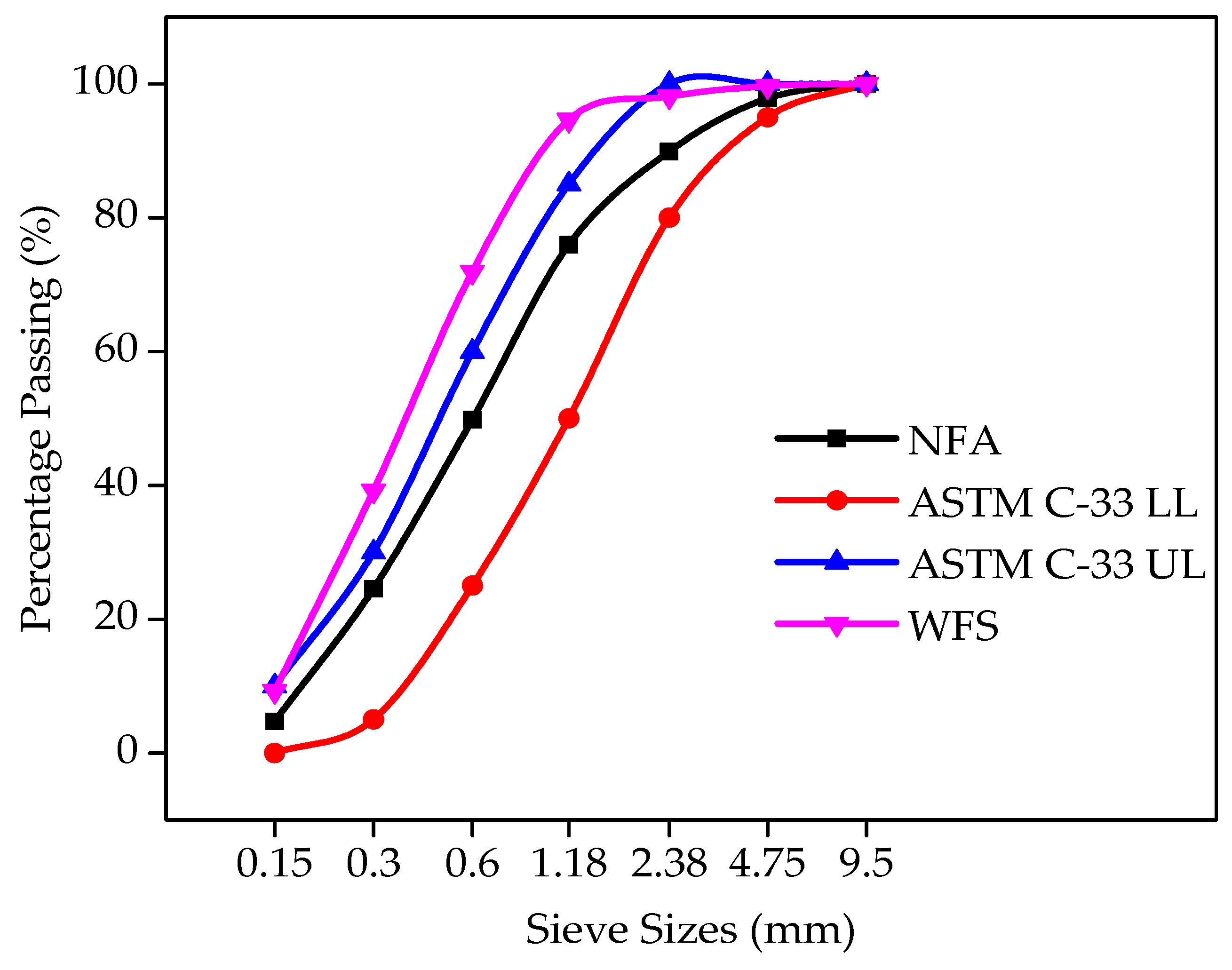
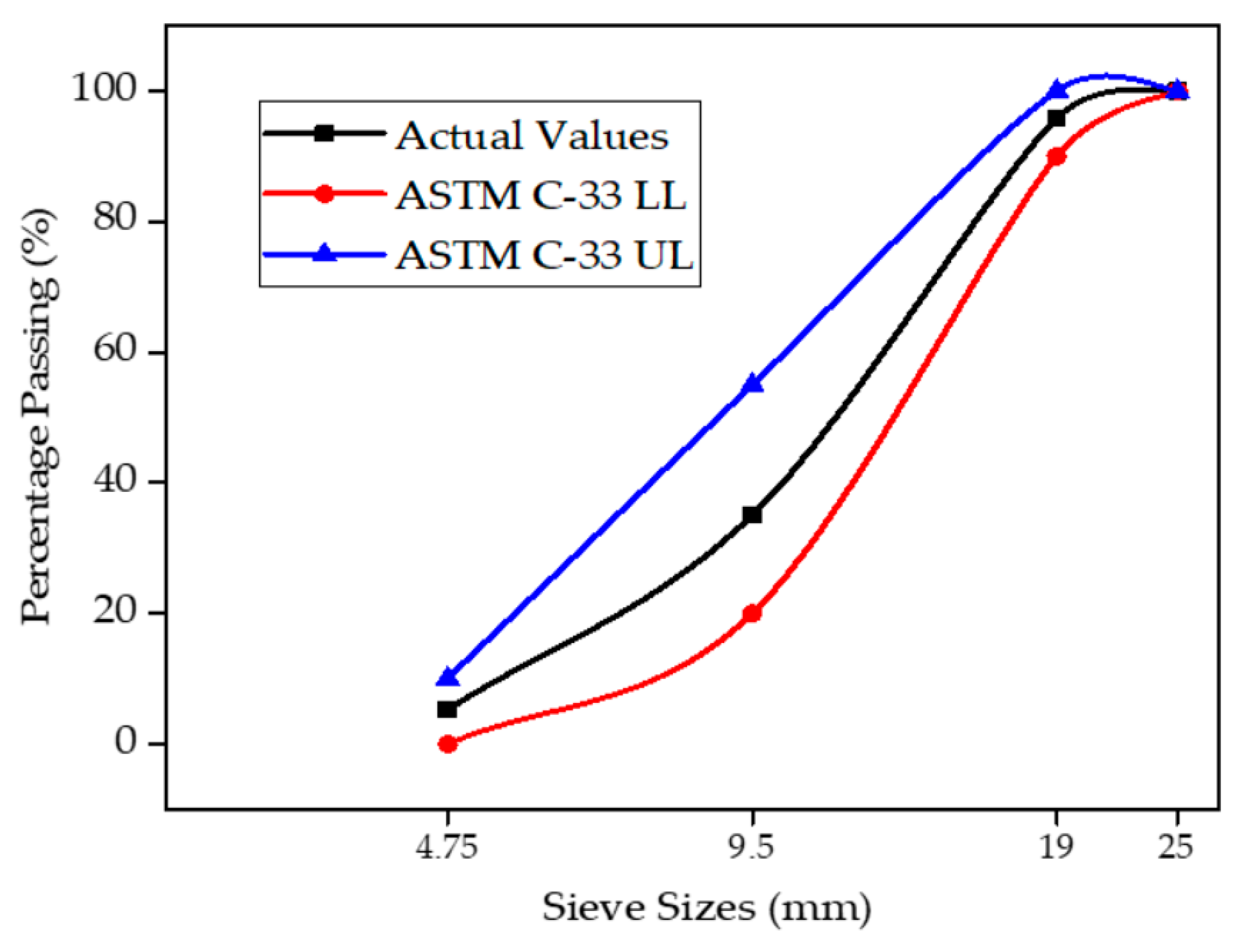
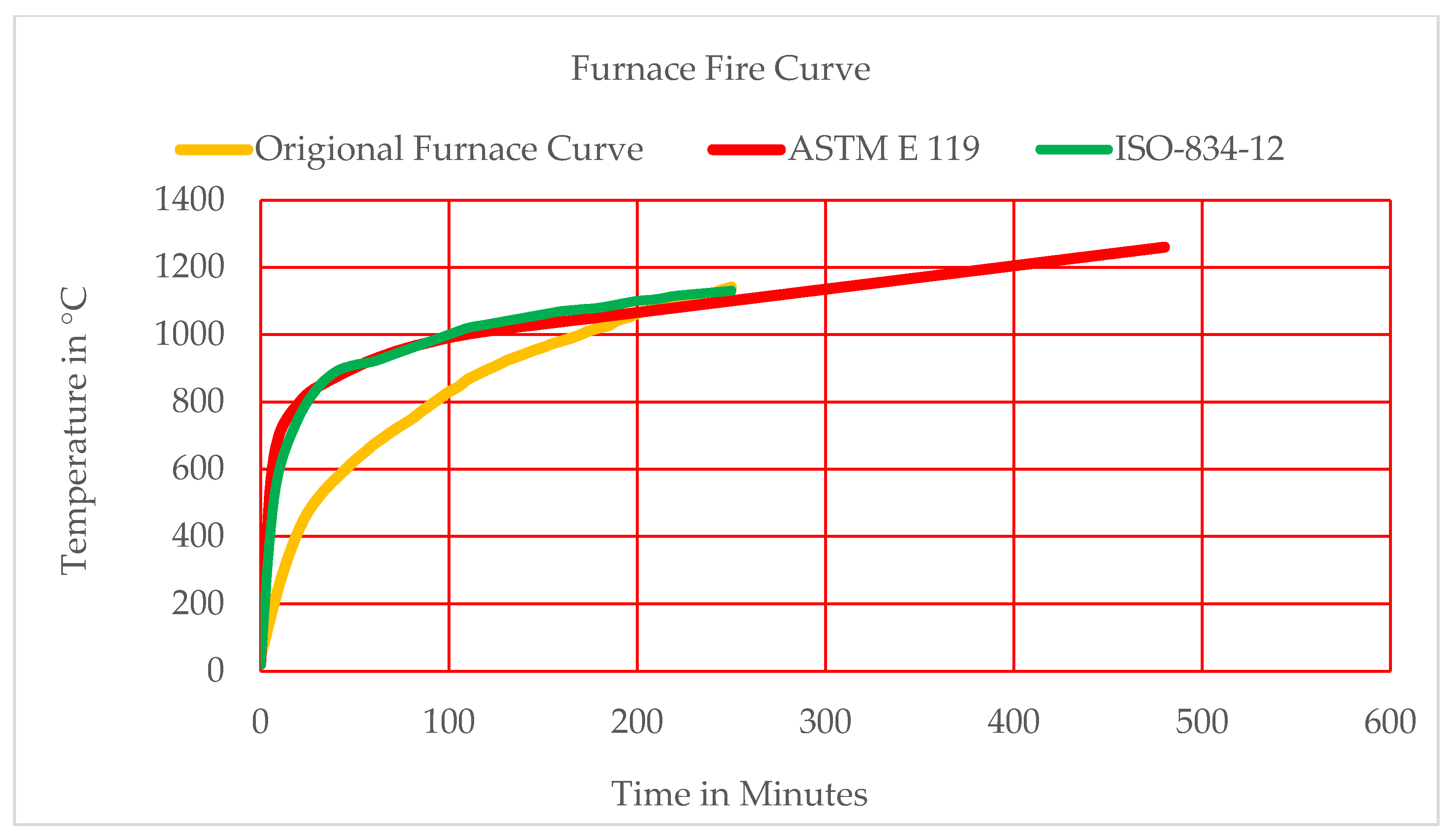
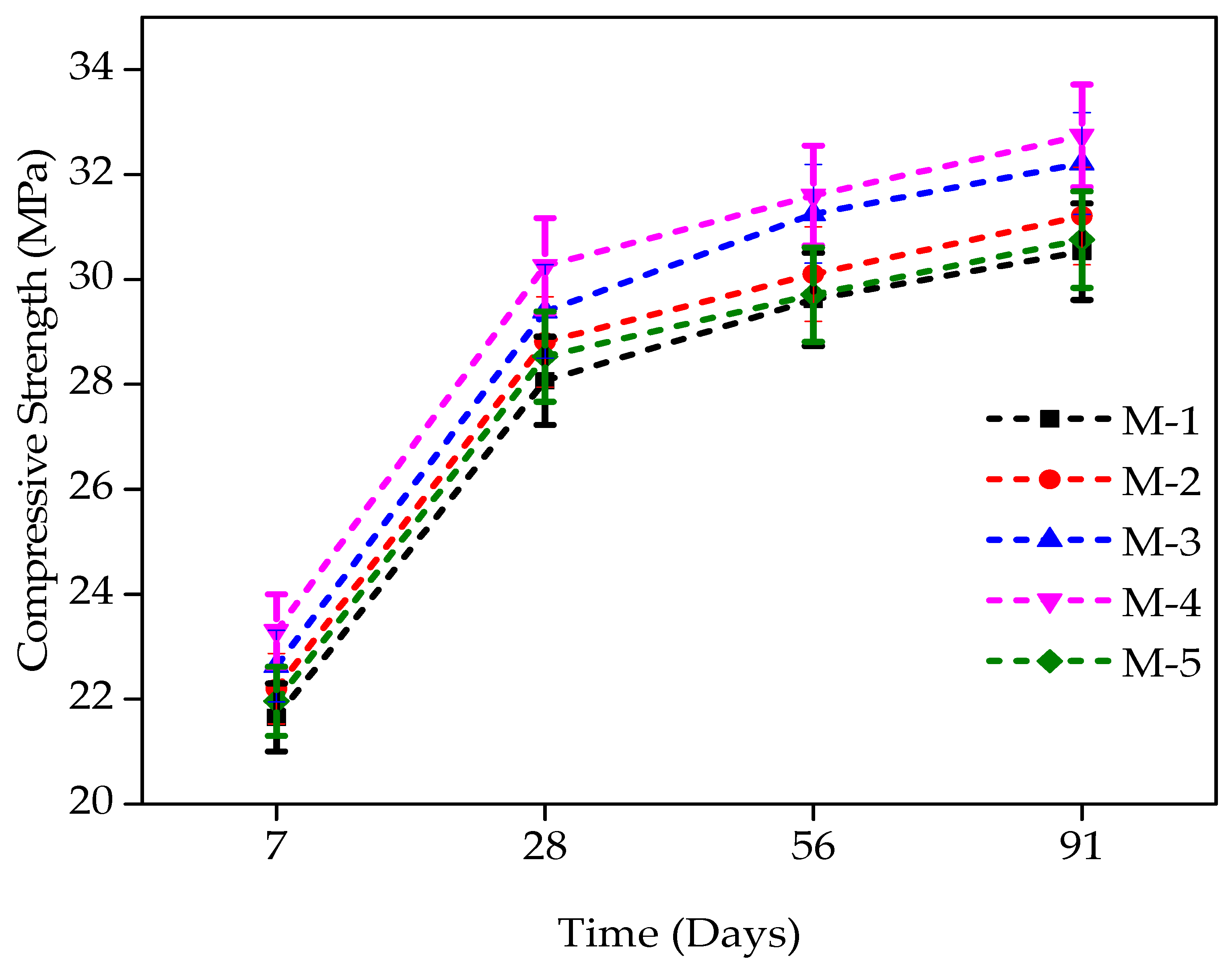

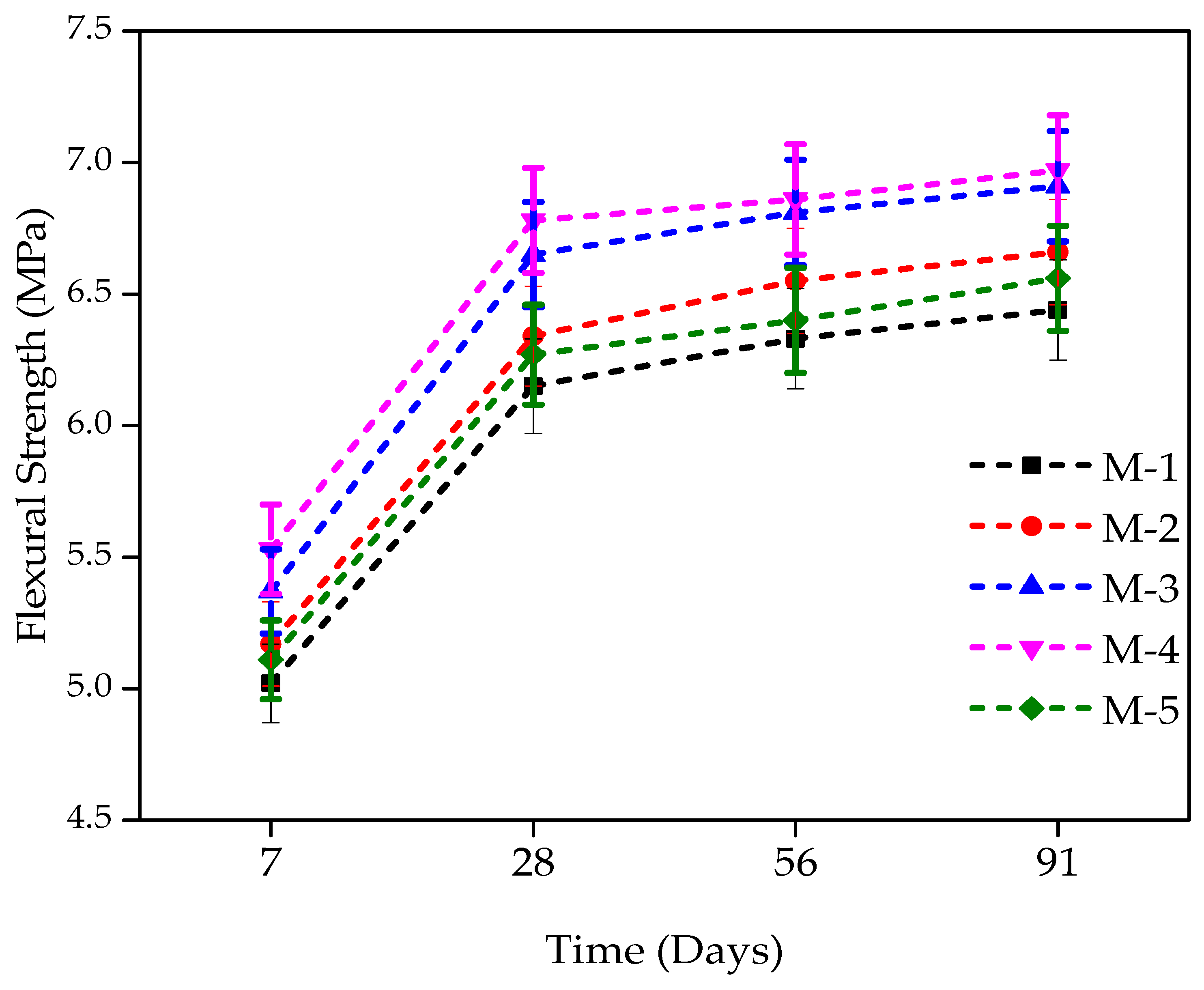
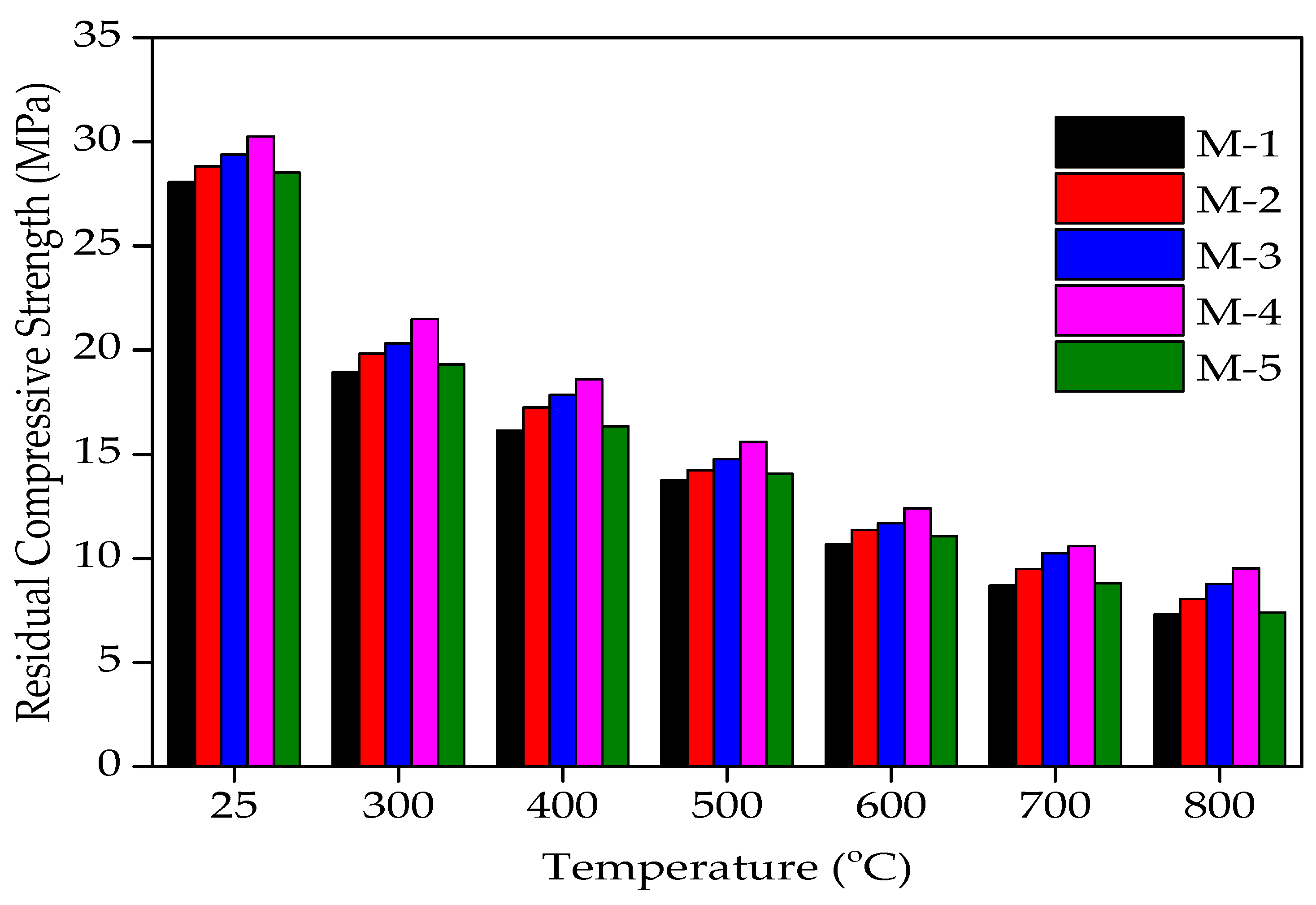

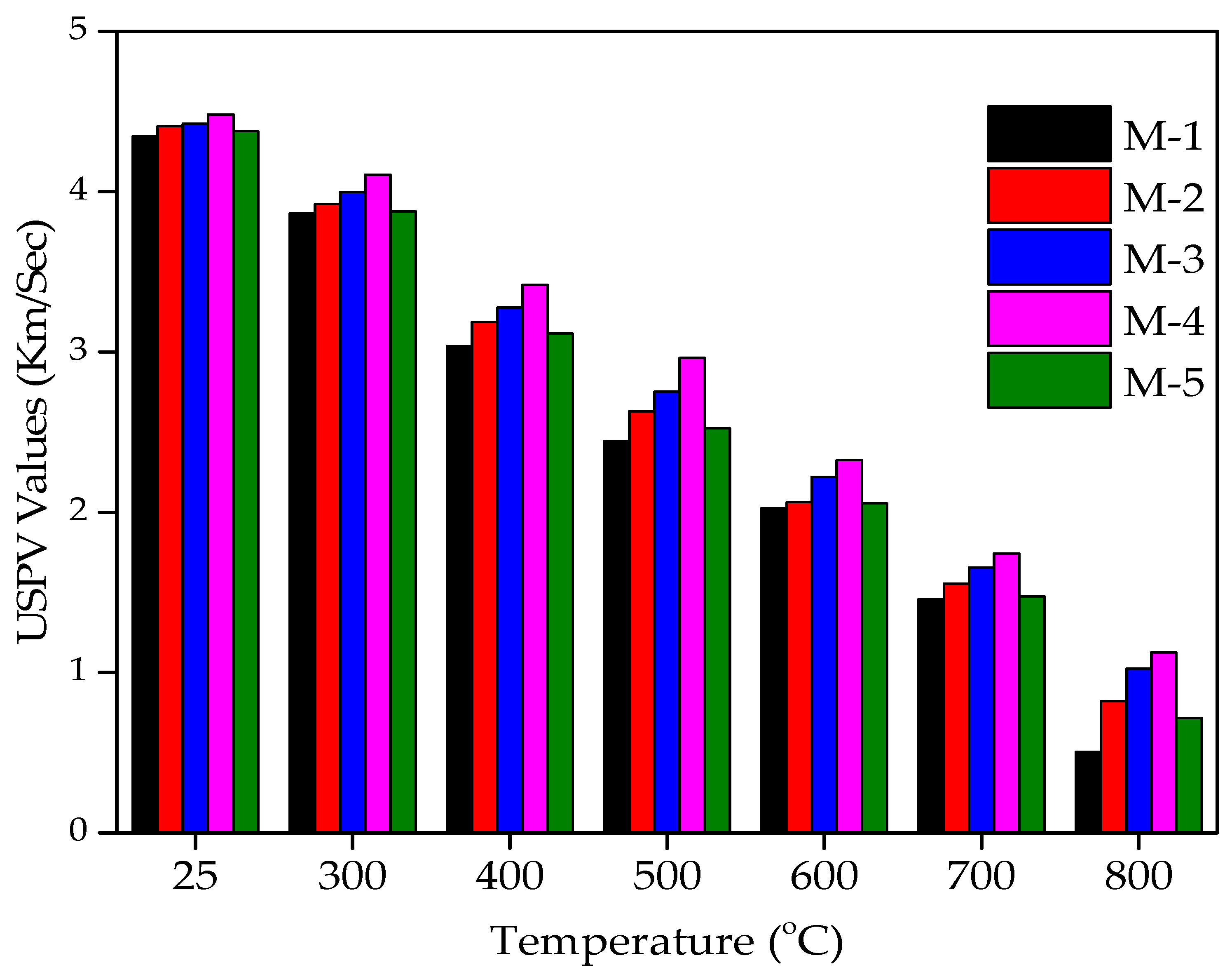
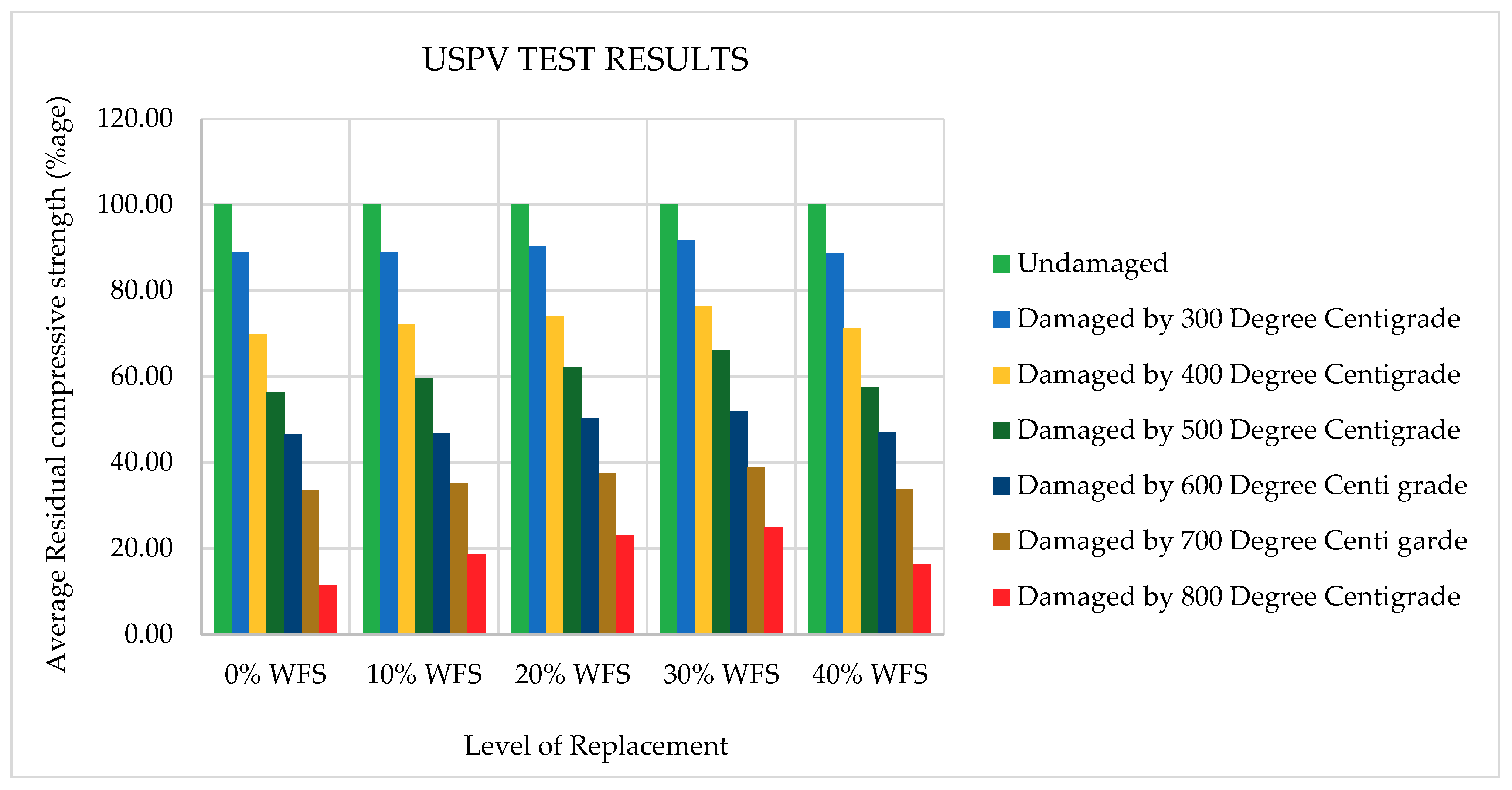
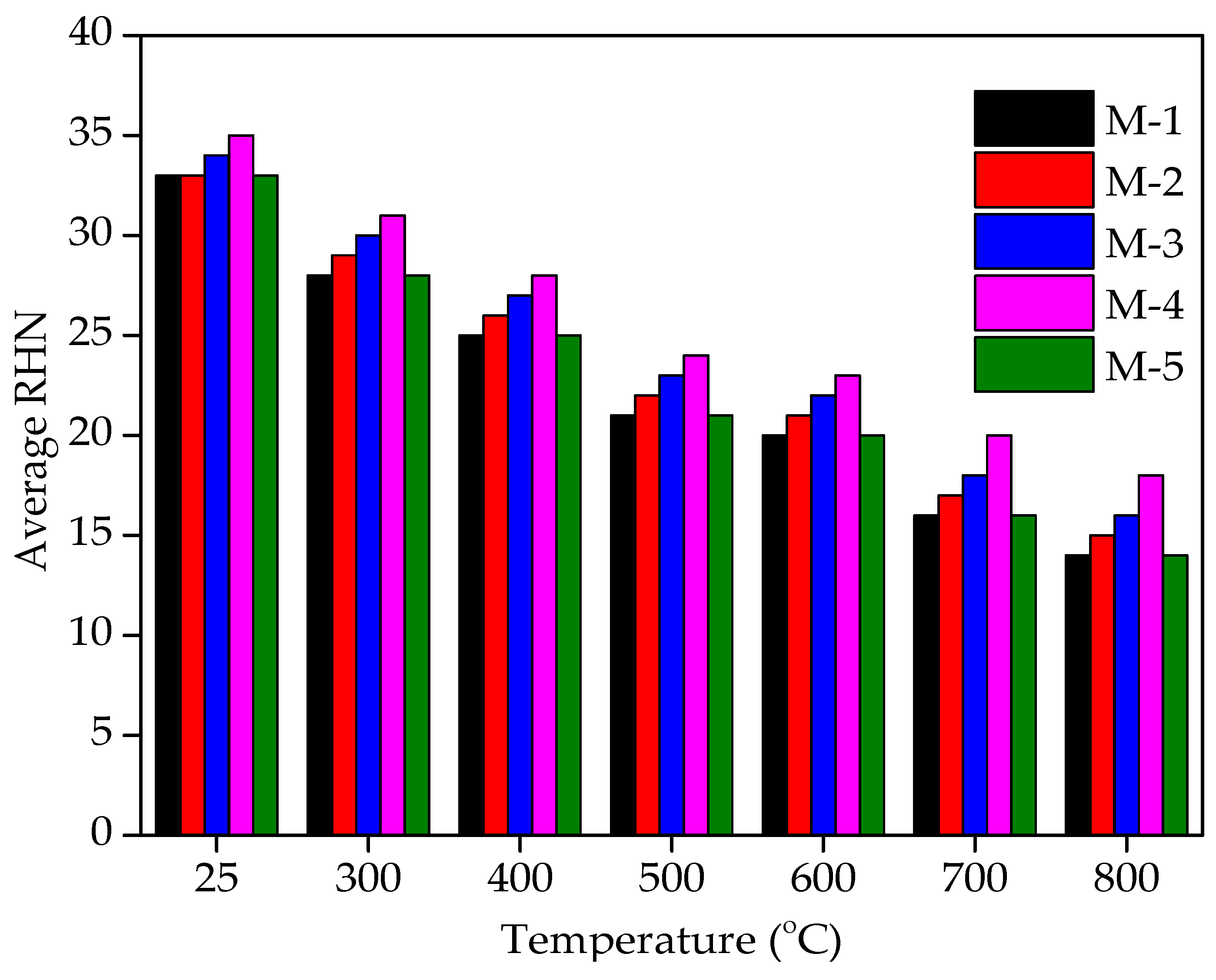
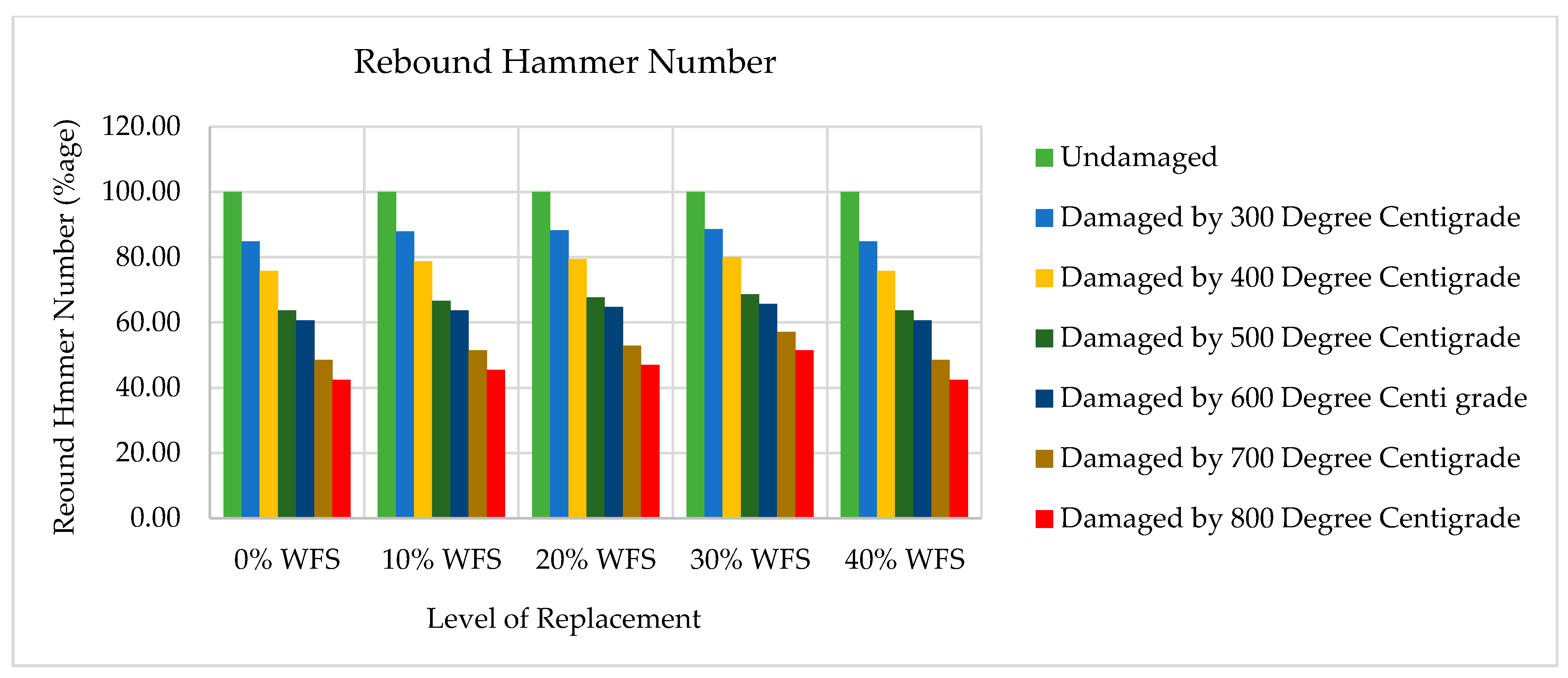


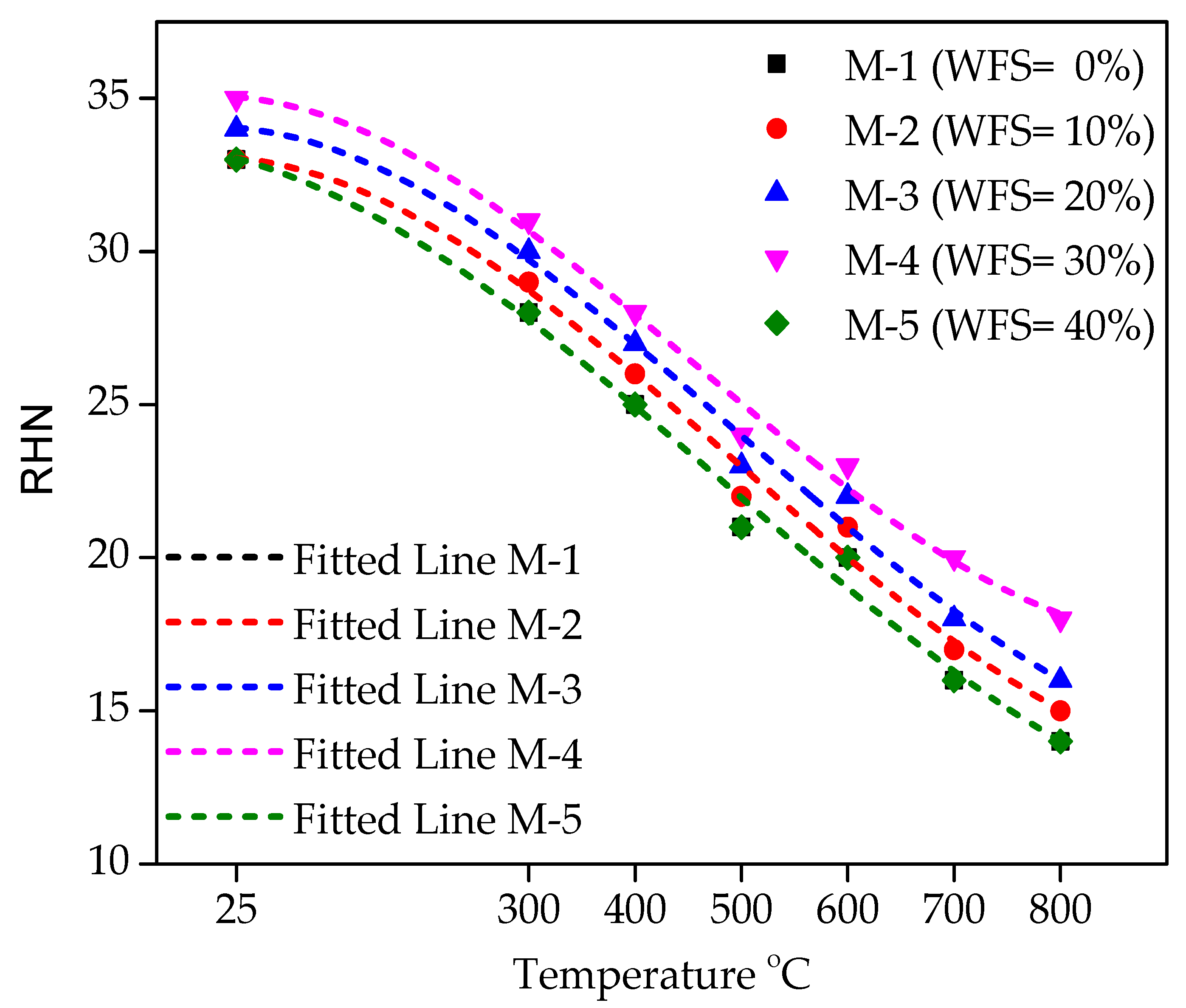
| Chemical Composition of Cement | Physical Properties of Cement | ||
|---|---|---|---|
| Components | Content (%) | Parameter | Value |
| CaO | 63.47 | Specific Surface | 322 m2/kg |
| SiO2 | 22.00 | Consistency | 29% |
| Al2O3 | 5.50 | Initial Setting Time | 1 h and 42 min |
| MgO | 1.70 | Final Setting Time | 3 h and 55 min |
| SO3 | 1.82 | Specific Gravity | 3.05 |
| Fe2O3 | 3.50 | - | - |
| Na2O | 0.20 | - | - |
| K2O | 1.00 | - | - |
| Loss of Ignition (LOI) | 0.64 | - | - |
| Component | Contents (%) | Requirements as per American Foundry Men’s Society, 1991 |
|---|---|---|
| SiO2 | 88.50 | 87.9% |
| Al2O3 | 4.63 | 4.70% |
| Fe2O3 | 0.83 | 0.94% |
| MgO | 0.21 | 0.30% |
| CaO | 0.90 | 0.14% (Min.) |
| Na2O | 0.02 | – |
| K2O | 0.01 | – |
| Sulphates | 0.03 | 0.09% |
| Loss of Ignition (LOI) | 4.37 | 5.15% (max.) |
| Property | Natural Sand | Coarse Aggregate | Waste Foundry Sand |
|---|---|---|---|
| Specific Gravity | 2.61 | 2.66 | 2.55 |
| Unit Weight (kg/m3) | 1720 | 1600 | 1555 |
| Fineness Modulus | 2.60 | - | 1.90 |
| Water Absorption (%) | 0.67 | 0.73 | 1.48 |
| Mix Designation | Level of Replacement | Cement (kg/m3) | WFS (kg/m3) | Fine Aggregate (kg/m3) | Coarse Aggregate (kg/m3) | Water (kg/m3) |
|---|---|---|---|---|---|---|
| M-1 | 0% | 436.4 | 0 | 654.5 | 1309.1 | 187.6 |
| M-2 | 10% | 436.4 | 65.4 | 589.1 | 1309.1 | 187.6 |
| M-3 | 20% | 436.4 | 130.9 | 523.6 | 1309.1 | 187.6 |
| M-4 | 30% | 436.4 | 196.4 | 458.2 | 1309.1 | 187.6 |
| M-5 | 40% | 436.4 | 261.8 | 392.7 | 1309.1 | 187.6 |
| Mix Designation | Level of Replacement | Actual Slump Achieved (mm) | Slump Value (%age reduction) | Compacting Factor Value |
|---|---|---|---|---|
| M-1 | 0% | 32 | Reference Slump | 0.85 |
| M-2 | 10% | 30 | 6.25 | 0.84 |
| M-3 | 20% | 30 | 6.25 | 0.84 |
| M-4 | 30% | 27 | 15.62 | 0.83 |
| M-5 | 40% | 22 | 31.25 | 0.81 |
| Testing Period | No. of Samples | Compressive Strength (MPa) | Variance (%) | Splitting Tensile Strength (MPa) | Variance (%) | Flexural Strength (MPa) | Variance (%) |
|---|---|---|---|---|---|---|---|
| 7 Days | Sample 1 | 20.81 | 0.00% | 1.84 | 0% | 4.89 | 0% |
| Sample 2 | 21.80 | 4.76% | 2.00 | 9% | 5.32 | 9% | |
| Sample 3 | 22.35 | 7.44% | 2.05 | 12% | 5.41 | 11% | |
| 28 Days | Sample 1 | 27.16 | 0.00% | 3.02 | 0% | 5.99 | 0% |
| Sample 2 | 28.09 | 3.42% | 3.36 | 11% | 6.14 | 2% | |
| Sample 3 | 28.96 | 6.63% | 3.43 | 13% | 6.31 | 5% | |
| 56 Days | Sample 1 | 29.36 | 0.00% | 3.31 | 0% | 6.04 | 0% |
| Sample 2 | 29.56 | 0.68% | 3.39 | 2% | 6.37 | 5% | |
| Sample 3 | 29.96 | 2.04% | 3.50 | 6% | 6.57 | 9% | |
| 91 Days | Sample 1 | 30.25 | 0.00% | 3.34 | 0% | 6.18 | 0% |
| Sample 2 | 30.57 | 1.06% | 3.44 | 3% | 6.57 | 6% | |
| Sample 3 | 30.80 | 1.82% | 3.68 | 10% | 6.58 | 7% |
© 2019 by the authors. Licensee MDPI, Basel, Switzerland. This article is an open access article distributed under the terms and conditions of the Creative Commons Attribution (CC BY) license (http://creativecommons.org/licenses/by/4.0/).
Share and Cite
Bilal, H.; Yaqub, M.; Rehman, S.K.U.; Abid, M.; Alyousef, R.; Alabduljabbar, H.; Aslam, F. Performance of Foundry Sand Concrete under Ambient and Elevated Temperatures. Materials 2019, 12, 2645. https://doi.org/10.3390/ma12162645
Bilal H, Yaqub M, Rehman SKU, Abid M, Alyousef R, Alabduljabbar H, Aslam F. Performance of Foundry Sand Concrete under Ambient and Elevated Temperatures. Materials. 2019; 12(16):2645. https://doi.org/10.3390/ma12162645
Chicago/Turabian StyleBilal, Hazrat, Muhammad Yaqub, Sardar Kashif Ur Rehman, Muhammad Abid, Rayed Alyousef, Hisham Alabduljabbar, and Fahid Aslam. 2019. "Performance of Foundry Sand Concrete under Ambient and Elevated Temperatures" Materials 12, no. 16: 2645. https://doi.org/10.3390/ma12162645
APA StyleBilal, H., Yaqub, M., Rehman, S. K. U., Abid, M., Alyousef, R., Alabduljabbar, H., & Aslam, F. (2019). Performance of Foundry Sand Concrete under Ambient and Elevated Temperatures. Materials, 12(16), 2645. https://doi.org/10.3390/ma12162645






